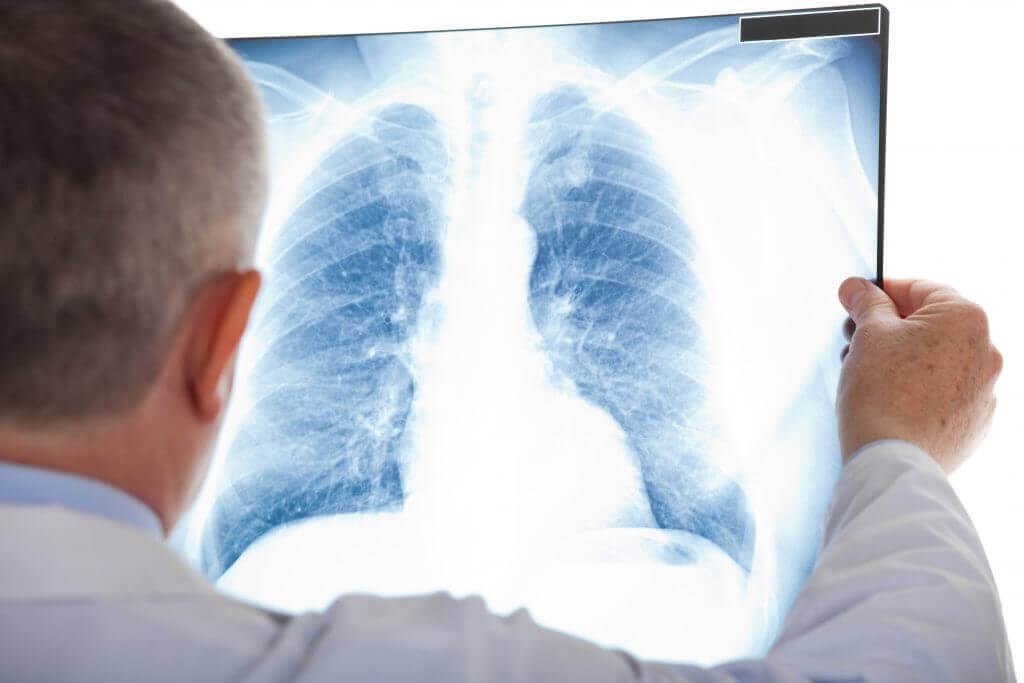The Symptoms and Causes of Atelectasis

The word atelectasis comes from atele-vs (incomplete) and éktasis (expansion). It’s a disorder where part of the lung becomes devoid of air and collapses. Today, we’ll tell you all about the symptoms and causes of atelectasis.
This condition can involve the entire lung or just one part (lobe). In general, it occurs as the result of an obstruction of the airways or pressure on the external part of the lung. Therefore, the alveoli deflate or fill with liquid.
This is a frequent complication when it comes to certain respiratory problems. For example, it can occur in patients that have cystic fibrosis, tumors in the lung, thoracic surgeries, etc. In fact, it can also occur when a person inhales a foreign object. Those who experience atelectasis can experience difficulty breathing.
In the paragraphs below, you’ll discover all you need to know about this condition.
The symptoms of Atelectasis

When talking about the symptoms and causes of atelectasis, it’s important to differentiate between this condition and pneumothorax. A pneumothorax occurs when air escapes from the lung. So, atelectasis is a decrease in the amount of air in the lungs with a loss of volume of the affected lung, while pneumothorax is the presence of air in the pleura.
Atelectasis doesn’t produce any clear symptoms. In fact, when it affects just one part of the lung, or it develops slowly, the symptoms can be imperceptible. On the other hand, if it affects are a large number of alveoli, then the symptoms can be very serious. The same is true when the disorder develops rapidly.
Among the symptoms of atelectasis, we can mention the following:
- Difficulty breathing
- Agitated or superficial breathing
- Cough
- Wheezing
- Thoracic pain, which occurs mainly when the cause of the disorder is trauma or pneumonia
- Tachycardia or hypotension (low blood pressure)
- Cyanosis, which is due to hypoxemia and is the result of a decrease in the exchange of gases
When breathing becomes progressively more difficult, then seeking medical attention is fundamental.
You may also want to read: Respiratory Diseases in Newborns
The causes of atelectasis
First of all, atelectasis can be caused by an obstruction of the bronchial tubes of the bronchioles. It can also occur as a result of pressure on the external part of the lung.
Furthermore, general anesthesia is another common cause. That’s because it changes the regular rhythm of breathing and, as a result, affects the exchange of cases. Therefore, anesthesia can cause the alveoli to deflate. Almost all people who undergo major surgery develop some degree of atelectasis.
To mention the most common causes of atelectasis, we must distinguish between obstructive and non-obstructive atelectasis.
The causes of obstructive atelectasis
- Foreign bodies: This is especially common among children, who tend to inhale small objects, such as toy parts.
- Mucous plug: This is an accumulation of mucous in the respiratory airways. It often occurs during surgery, because not being able to cough makes it difficult to expel mucous. This can also occur because many of the medications taken can reduce the depth of breathing. Therefore, mucous tends to accumulate. In individuals with cystic fibrosis and asthma, mucous plugs are common.
- Tumors: A tumor in the airways causes them to become narrower, which can make obstruction possible.
The causes of non-obstructive atelectasis
In this case, the possible causes include:
- Trauma: When trauma occurs, the pain reduces the depth of a person’s breathing and can lead to compression of the lungs.
- Pleural effusion: Pleural effusion consists of an accumulation of liquid between the pulmonary pleura and the inside of the thoracic wall.
- Pneumonia.
- Scars on pulmonary tissue. Lesions from pulmonary disease or surgery can produce scarring.
Discover more: Optimize Your Lungs by Adding these Food Items to Your Diet
The diagnosis of atelectasis

To diagnosis atelectasis, a proper clinical exploration and an X-ray will usually suffice. Just the same, doctors may use a series of techniques to confirm the diagnosis or determine the degree of seriousness.
These techniques include a CT scan (computerized tomography), bronchoscopy, ultrasound, and oximetry. In fact, bronchoscopy allows for the observation of obstructions and even the elimination of blockage.
Treatment of atelectasis
Treating atelectasis varies according to the cause. In fact, mild atelectasis may go away on its own without treatment. In cases that require treatment, the main options are the following:
- The elimination of the obstruction through bronchoscopy
- Tapping the thorax to loosen up mucous plugs
- Inhaled medicines that open the respiratory airways. Doctors also prescribe them to reduce mucous.
- In the case of tumors, the treatment of atelectasis involves treating the tumor
Conclusion
Atelectasis is a disorder that can easily go unnoticed. However, it can also be a serious problem and be the result of a subjacent condition. Therefore, it’s important to know the causes and symptoms of atelectasis to establish the best treatment, if necessary.
If you experience any difficulty breathing, seek medical attention immediately.
All cited sources were thoroughly reviewed by our team to ensure their quality, reliability, currency, and validity. The bibliography of this article was considered reliable and of academic or scientific accuracy.
- Duggan, M., & Kavanagh, B. P. (2005). Pulmonary atelectasis: a pathogenic perioperative entity. Anesthesiology, 102(4), 838–54. Retrieved from http://www.ncbi.nlm.nih.gov/pubmed/15791115
- Hedenstierna, G., & Edmark, L. (2010, June). Mechanisms of atelectasis in the perioperative period. Best Practice and Research: Clinical Anaesthesiology. https://doi.org/10.1016/j.bpa.2009.12.002
- Magnusson, L. (2003). New concepts of atelectasis during general anaesthesia. British Journal of Anaesthesia, 91(1), 61–72. https://doi.org/10.1093/bja/aeg085
- Schindler, M. B. (2005). Treatment of atelectasis: Where is the evidence? Critical Care, 9(4), 341–342. https://doi.org/10.1186/cc3766
- Peroni, D. G., & Boner, A. L. (2000). Atelectasis: Mechanisms, diagnosis and management. Paediatric Respiratory Reviews, 1(3), 274–278. https://doi.org/10.1054/prrv.2000.0059
This text is provided for informational purposes only and does not replace consultation with a professional. If in doubt, consult your specialist.








